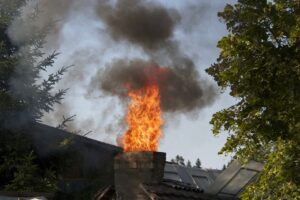
Creosote can coat the inside of your fireplace and chimney, leading to damage and possible health risks.
The warmth and atmosphere from a roaring, crackling fire are tough to beat. However, while you’re enjoying the coziness, there’s a hidden danger you may overlook — creosote. This black, sticky substance can coat the inside of your fireplace and chimney, leading to damage and possible health risks. Let’s go over creosote, the risks, and how to protect your home and family.
What is Creosote?
Creosote is a natural byproduct of burning wood, particularly from incomplete combustion. It forms when gases, water vapor, and other particles in the wood’s smoke combine and cool as they rise through the chimney. These particles condense along the chimney’s walls, eventually building into a sticky, highly flammable substance called creosote. Creosote develops in three distinct stages, each with varying danger levels. The first stage is loose and powdery. This form is easy to remove and poses little risk. As it accumulates, the creosote becomes denser and forms a flaky texture. It’s more difficult to remove at this stage and presents a moderate fire hazard. In the third stage, creosote hardens into a thick, tar-like substance that requires a professional to remove. It’s highly flammable and can obstruct airflow as it thickens.
Creosote Buildup is a Fire Hazard
The main risk from creosote buildup is a chimney fire. According to The Chimney Safety Institute of America, chimney obstructions are the primary causes of chimney fires, and creosote buildup is a significant factor. Many chimney fires go unnoticed initially, but the constant high temperatures will eventually cause an ignition that could spread to your house.
Creosote Buildup Leads to Health Risks
Besides fire, creosote can release harmful chemicals and pollutants into the home that, if breathed in, can irritate your lungs and cause other health issues.
Reduced Efficiency
If allowed to grow, creosote will thicken to where it blocks airflow through the chimney. Poor airflow reduces your fire’s efficiency, causing you to burn more fuel or use your furnace more, increasing your heating costs.
Chimney Damage
Creosote is highly corrosive and damaging. Over time, the chemicals can damage the flue liner or the chimney’s masonry materials, resulting in costly repairs or rebuilds.
Schedule Regular Inspections to Minimize Creosote Buildup
The best way to prevent creosote buildup and keep your family safe is to schedule annual cleaning and inspections by a certified chimney professional. These experts have the proper tools to thoroughly remove creosote and check for evidence of prior fires that could lead to disaster.
Call the Experts at Champion Chimneys for Chimney Sweeping Today!
Champion Chimneys, Inc. is a fully licensed, bonded, and insured chimney service company that has been serving customers in Baltimore County, Howard County, and Anne Arundel County, Maryland since 2001. Our team is trained and certified by Certified Chimney Professionals, Inc. (CCP, Inc.). Courteous service is our trademark, and our crews arrive on time in uniform, driving fully equipped trucks. We specialize in all aspects of your chimney system. Whether you need chimney and flue cleaning service or a full chimney rebuild or inspection, contact us at 443-Chimney today and let us fix all your chimney problems. Also, follow us on Facebook, Twitter, LinkedIn, and Pinterest.
